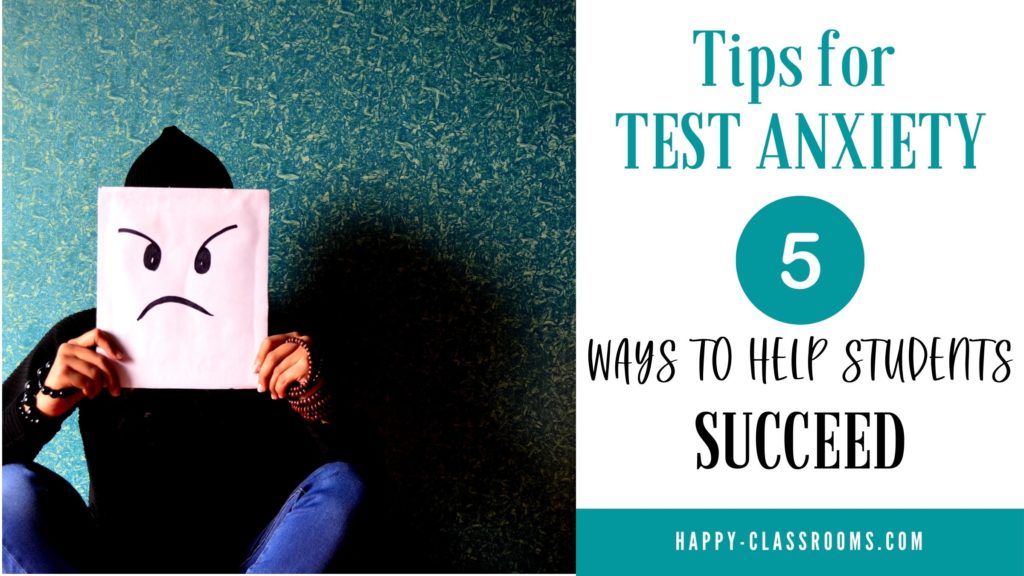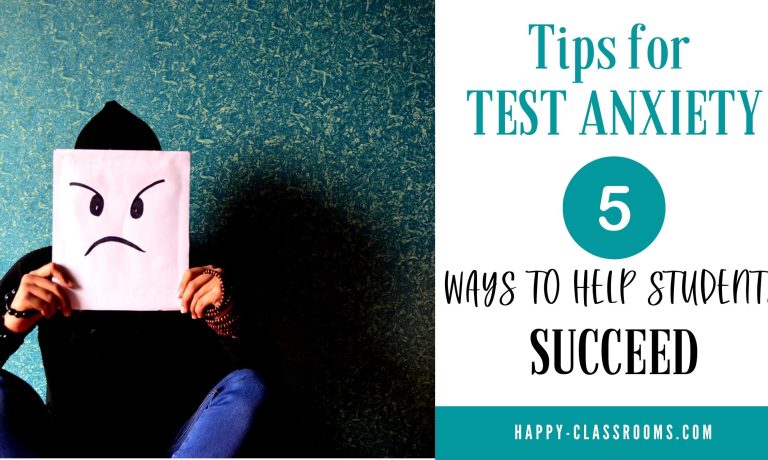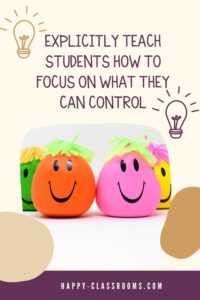Do you remember needing tips on test anxiety when taking finals in high school or college? I do! I have a degree in multiple languages and I still have a nightmare where I sit down to take my final in say Italian or French, and the test is in a language that I don’t understand. These days that kind of anxiety isn’t reserved just for high-stakes tests like finals and SATs. It seems we are seeing students suffering from test anxiety with annual standardized tests and even weekly and monthly benchmark tests.
While some people thrive on stress, there is plenty of evidence to show test anxiety can have an adverse effect on young people. Students who report feeling more anxious before taking tests often score lower than their peers, regardless of how much sleep they got or their grades in other subjects. So how to relieve test anxiety is an important issue. These tips should be able to help.
Before we dive in, let me ask you this. Are you looking to have a more positive teaching experience? Grab the free digital download of my best-selling Positive Mindset Journal for Teachers by clicking here.

How to Relieve Test Anxiety – Create a Positive Environment
The first way to relieve test anxiety for students is to create a calming, yet positive environment in the classroom. Consider the following:
- Play calming ambient music. Nothing is more annoying than hearing a student sniff or tap their pencil when there is complete silence in the room.
- While making sure no one has to strain their eyes, dim harsh lights, if possible.
- Make sure there is plenty of time to start and complete the test, and provide breaks at reasonable intervals.
- Allow students to have access to water and a snack if it is a long test. Some students may have been too nervous to eat breakfast, but start to feel hungry once they settle into the test.
- Put “Do Not Disturb” signs on the doors and remind the office not to call your room so as not to cause distractions and break students out of their “flow” state.

Focus on Social & Emotional Learning Skills and Relaxation Techniques
One of the goals of social and emotional learning is that of “self-regulation.” In order to reduce test anxiety, it is important that we focus on lessons and activities that help students with emotional regulation all year, not only during test time. Some practices to consider:
- Teach students how to refocus and calm anxiety by slowing down their breath and using different breathing techniques. Lower grades can benefit from “Starfish” or “Take Five” Breathing (tracing the outline of the fingers of their outstretched hand while breathing slowly in and out).
- Older students can benefit from “4-7-8” breathing. With this technique, students close their eyes and breathe in through their nose to the count of four, hold their breath for a count of seven, and exhale through their mouth for a count of eight.
- Practice mindfulness activities such as having students visualize themselves in a calm, relaxing, safe environment (their “happy place”)
Again, it is important to work on these techniques before test time, so that students are confident and comfortable in using them. The ultimate goal is for students to take ownership of managing their anxiety level independent of the teacher.
Consider making a cheat sheet of practices students can use from their “anxiety-reducing tool kit” and either projecting it on the wall or putting a copy on each students’ desk. Model taking some deep breaths together as you get started on the test.
Growth Mindset Activities and Perspective
Another key component to relieve test anxiety is to focus on growth mindset activities throughout the year. Completing activities that remind students of the “power of yet” (it’s not that they don’t know how to do things required of them, it’s that they don’t know them “yet”) is a top tip for test anxiety.
Helping students maintain perspective is also critical. Explain that it is “normal” to feel anxiety about tests. Remind students that assessments are for the teacher’s benefit – they help the teachers know what students have mastered and what they need to work more on. Assessment should drive instruction and help teachers decide what to reteach, and to determine which students would benefit from more intensive interventions.
Additionally, I like to remind students is that the test will be over in an hour or so, and then everything about their life will still be the same. They’ll still have the same family, friends, and teacher. They’ll live in the same house and go home to the same pets. If it’s a “high stakes” test such as high school finals where their choice of colleges may be affected, this strategy may not apply. But for most tests, it will be valid.
Positive Bulletin Boards
For many assessments, any posters on the wall that contain content that can help on the test need to be removed. For example, math formulas or charts for English Language Arts and Writing. To cover up the depressing bare walls and to inspire students I put positive posters on the wall to remind them of the following:
- A test is just a moment in time
- Their only competition is themselves
- They are capable of doing difficult things
- They should focus on doing their best
- Teachers care more about growth than grades
Handing out positive growth mindset-focused notes is also a fun way to relieve some pressure.
DONE FOR YOU PRO TIP: If you would like a complete done-for-you Positive Testing Focus Wall as well as co-ordinating positive notes, check out this resource. If you are fed up with most teacher-created resources being “cutesy” and geared toward younger students, you will be pleasantly surprised. The focus wall, notes, and “calming strategies” included in the resource are appropriate for all grades, even high school.
Help Students Focus on What They Can Control
One of the reasons students struggle with test anxiety is that they are stressed that they “don’t know what will be on the test.” They may also have pressure from home or anxiety triggers such as perfectionism fear of failure.
Teaching students to focus on what they can control and to let go of concern about what they cannot control is a powerful strategy. It can help students be successful in many areas of life, not just test-taking.
Remind students that you have covered all the material in class. Remind them that even though they don’t know what questions they will have on the test, they are in control of:
- Their attitude
- How hard they study and how well prepared they are
- Their ability to practice relaxation techniques
A great activity for students of all ages Circles of Concern v. Circle of Influence. You can check these done-for-you lesson plans appropriate for different grade levels HERE
Being proactive about helping older students set their own realistic goals and make a study plan will also give them confidence and a sense of control.
Obviously, one practical way to help students feel more in control is to teach them test-taking strategies. If they feel empowered that they have a strong strategy in place with how to deal with questions they are not sure about, they will feel more confident and will be less likely to feel overwhelmed and defeated. Familiarizing your class with the format of the questions, taking “mock” exams, and studying exemplary answers will also reduce their anxiety level.
How Not To Have Test Anxiety – Enlist Family Help
The last element for setting students up for testing success is to involve their families. Ensure that parents and guardians are aware of when testing is taking place and setting them up for success by doing the following:
- Providing them with a quiet place to study
- Making sure they get a good night’s sleep
- Making sure they eat a healthy breakfast and have a snack and water with them
- Encouraging them to do their best, but not to stress or feel pressured to have the top score
You can check out a simple resource for parents with tips on test anxiety by clicking here.
Summary – How To Relieve Test Anxiety
Testing can be very stressful for students and teachers, especially when it comes to high-stakes standardized tests. One of the best ways to help students with test anxiety is by providing them with a calming environment. This could be as simple as dimming lights, playing calm music, and providing them with a positive note before they get started. Make practicing relaxation and self-calming strategies, such as deep breathing and muscle relaxation exercises, a habit throughout the year so that when the big day comes, students are already comfortable and proficient with the techniques. Focus on growth mindset activities throughout the year. Teach your students to reduce stress by focusing on what they can control and not worrying about competing with someone else. Finally, ensure students are well-rested and set up for success by communicating best practices with student families.
Here are some other articles on tips on test anxiety that you might find helpful:
https://childmind.org/article/tips-for-beating-test-anxiety/
https://www.healthline.com/health/test-anxiety#tips
https://www.therapistaid.com/therapy-worksheet/study-tips
Help out another teacher! What’s been most helpful for you when helping students deal with the stress of exams? Leave your questions or best tips on test anxiety in the comments below.
Skimmed to the end? Here’s the same content on video




